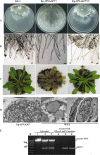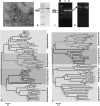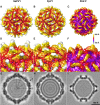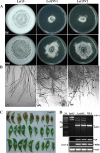A novel partitivirus that confers hypovirulence on plant pathogenic fungi
- PMID: 24965462
- PMCID: PMC4136314
- DOI: 10.1128/JVI.01036-14
A novel partitivirus that confers hypovirulence on plant pathogenic fungi
Abstract
Members of the family Partitiviridae have bisegmented double-stranded RNA (dsRNA) genomes and are not generally known to cause obvious symptoms in their natural hosts. An unusual partitivirus, Sclerotinia sclerotiorum partitivirus 1 (SsPV1/WF-1), conferred hypovirulence on its natural plant-pathogenic fungal host, Sclerotinia sclerotiorum strain WF-1. Cellular organelles, including mitochondria, were severely damaged. Hypovirulence and associated traits of strain WF-1 and SsPV1/WF-1 were readily cotransmitted horizontally via hyphal contact to different vegetative compatibility groups of S. sclerotiorum and interspecifically to Sclerotinia nivalis and Sclerotinia minor. S. sclerotiorum strain 1980 transfected with purified SsPV1/WF-1 virions also exhibited hypovirulence and associated traits similar to those of strain WF-1. Moreover, introduction of purified SsPV1/WF-1 virions into strain KY-1 of Botrytis cinerea also resulted in reductions in virulence and mycelial growth and, unexpectedly, enhanced conidial production. However, virus infection suppressed hyphal growth of most germinating conidia of B. cinerea and was eventually lethal to infected hyphae, since very few new colonies could develop following germ tube formation. Taken together, our results support the conclusion that SsPV1/WF-1 causes hypovirulence in Sclerotinia spp. and B. cinerea. Cryo-EM (cryo-electron microscopy) reconstruction of the SsPV1 particle shows that it has a distinct structure with similarity to the closely related partitiviruses Fusarium poae virus 1 and Penicillium stoloniferum virus F. These findings provide new insights into partitivirus biological activities and clues about molecular interactions between partitiviruses and their hosts.
Importance: Members of the Partitiviridae are believed to occur commonly in their phytopathogenic fungal and plant hosts. However, most partitiviruses examined so far appear to be associated with latent infections. Here we report a partitivirus, SsPV1/WF-1, that was isolated from a hypovirulent strain of Sclerotinia sclerotiorum and describe its biological and molecular features. We have demonstrated that SsPV1 confers hypovirulence. Furthermore, SsPV1 can infect and cause hypovirulence in Botrytis cinerea. Our study also suggests that SsPV1 has a vigorous ability to proliferate and spread via hyphal contact. SsPV1 can overcome vegetative incompatibility barriers and can be transmitted horizontally among different vegetative compatibility groups of S. sclerotiorum, even interspecifically. Cryo-EM reconstruction of SsPV1 shows that it has a distinct structure with similarity to closely related partitiviruses. Our studies exploit a novel system, SsPV1 and its hosts, which can provide the means to explore the mechanisms by which partitiviruses interact with their hosts.
Copyright © 2014, American Society for Microbiology. All Rights Reserved.
Figures







Similar articles
-
A wild-type Botrytis cinerea strain co-infected by double-stranded RNA mycoviruses presents hypovirulence-associated traits.Virol J. 2013 Jul 2;10:220. doi: 10.1186/1743-422X-10-220. Virol J. 2013. PMID: 23816333 Free PMC article.
-
Co-infection of a hypovirulent isolate of Sclerotinia sclerotiorum with a new botybirnavirus and a strain of a mitovirus.Virol J. 2016 Jun 6;13:92. doi: 10.1186/s12985-016-0550-2. Virol J. 2016. PMID: 27267756 Free PMC article.
-
Identification of the Viral Determinant of Hypovirulence and Host Range in Sclerotiniaceae of a Genomovirus Reconstructed from the Plant Metagenome.J Virol. 2021 Aug 10;95(17):e0026421. doi: 10.1128/JVI.00264-21. Epub 2021 Aug 10. J Virol. 2021. PMID: 34132570 Free PMC article.
-
Viruses of the plant pathogenic fungus Sclerotinia sclerotiorum.Adv Virus Res. 2013;86:215-48. doi: 10.1016/B978-0-12-394315-6.00008-8. Adv Virus Res. 2013. PMID: 23498908 Review.
-
Viruses of botrytis.Adv Virus Res. 2013;86:249-72. doi: 10.1016/B978-0-12-394315-6.00009-X. Adv Virus Res. 2013. PMID: 23498909 Review.
Cited by
-
Partitiviruses Infecting Drosophila melanogaster and Aedes aegypti Exhibit Efficient Biparental Vertical Transmission.J Virol. 2020 Sep 29;94(20):e01070-20. doi: 10.1128/JVI.01070-20. Print 2020 Sep 29. J Virol. 2020. PMID: 32759315 Free PMC article.
-
Discovery and exploration of widespread infection of mycoviruses in Phomopsis vexans, the causal agent of phomopsis blight of eggplant in China.Front Plant Sci. 2022 Nov 10;13:996862. doi: 10.3389/fpls.2022.996862. eCollection 2022. Front Plant Sci. 2022. PMID: 36438156 Free PMC article.
-
Characterization of a Novel Megabirnavirus from Sclerotinia sclerotiorum Reveals Horizontal Gene Transfer from Single-Stranded RNA Virus to Double-Stranded RNA Virus.J Virol. 2015 Aug;89(16):8567-79. doi: 10.1128/JVI.00243-15. Epub 2015 Jun 10. J Virol. 2015. PMID: 26063429 Free PMC article.
-
Capsid Structure of dsRNA Fungal Viruses.Viruses. 2018 Sep 7;10(9):481. doi: 10.3390/v10090481. Viruses. 2018. PMID: 30205532 Free PMC article. Review.
-
Novel Partitivirus Enhances Virulence of and Causes Aberrant Gene Expression in Talaromyces marneffei.mBio. 2018 Jun 12;9(3):e00947-18. doi: 10.1128/mBio.00947-18. mBio. 2018. PMID: 29895639 Free PMC article.
References
Publication types
MeSH terms
Substances
Associated data
- Actions
- Actions
Grants and funding
LinkOut - more resources
Full Text Sources
Other Literature Sources
Miscellaneous

